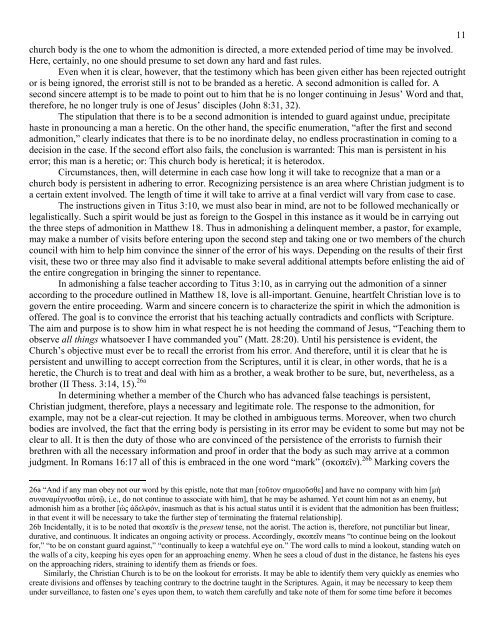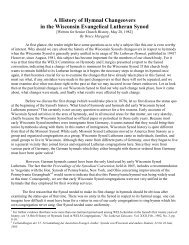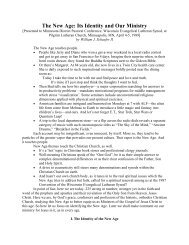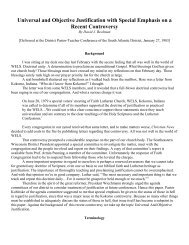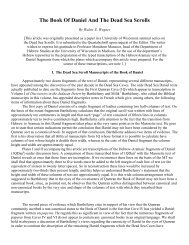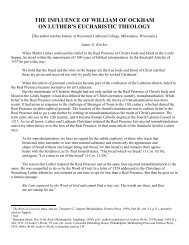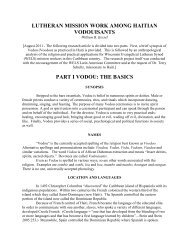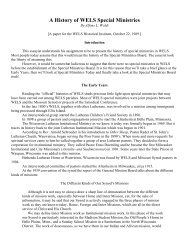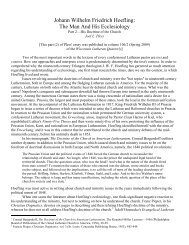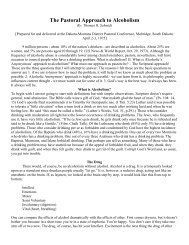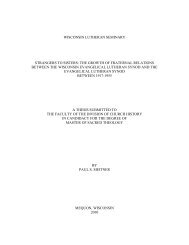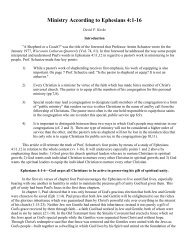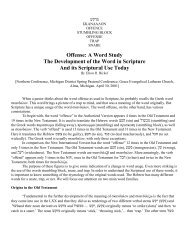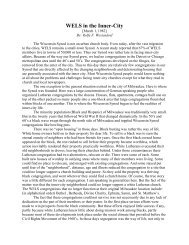What Is Heresy? - Wisconsin Lutheran Seminary Library: Essays
What Is Heresy? - Wisconsin Lutheran Seminary Library: Essays
What Is Heresy? - Wisconsin Lutheran Seminary Library: Essays
You also want an ePaper? Increase the reach of your titles
YUMPU automatically turns print PDFs into web optimized ePapers that Google loves.
11<br />
church body is the one to whom the admonition is directed, a more extended period of time may be involved.<br />
Here, certainly, no one should presume to set down any hard and fast rules.<br />
Even when it is clear, however, that the testimony which has been given either has been rejected outright<br />
or is being ignored, the errorist still is not to be branded as a heretic. A second admonition is called for. A<br />
second sincere attempt is to be made to point out to him that he is no longer continuing in Jesus’ Word and that,<br />
therefore, he no longer truly is one of Jesus’ disciples (John 8:31, 32).<br />
The stipulation that there is to be a second admonition is intended to guard against undue, precipitate<br />
haste in pronouncing a man a heretic. On the other hand, the specific enumeration, “after the first and second<br />
admonition,” clearly indicates that there is to be no inordinate delay, no endless procrastination in coming to a<br />
decision in the case. If the second effort also fails, the conclusion is warranted: This man is persistent in his<br />
error; this man is a heretic; or: This church body is heretical; it is heterodox.<br />
Circumstances, then, will determine in each case how long it will take to recognize that a man or a<br />
church body is persistent in adhering to error. Recognizing persistence is an area where Christian judgment is to<br />
a certain extent involved. The length of time it will take to arrive at a final verdict will vary from case to case.<br />
The instructions given in Titus 3:10, we must also bear in mind, are not to be followed mechanically or<br />
legalistically. Such a spirit would be just as foreign to the Gospel in this instance as it would be in carrying out<br />
the three steps of admonition in Matthew 18. Thus in admonishing a delinquent member, a pastor, for example,<br />
may make a number of visits before entering upon the second step and taking one or two members of the church<br />
council with him to help him convince the sinner of the error of his ways. Depending on the results of their first<br />
visit, these two or three may also find it advisable to make several additional attempts before enlisting the aid of<br />
the entire congregation in bringing the sinner to repentance.<br />
In admonishing a false teacher according to Titus 3:10, as in carrying out the admonition of a sinner<br />
according to the procedure outlined in Matthew 18, love is all-important. Genuine, heartfelt Christian love is to<br />
govern the entire proceeding. Warm and sincere concern is to characterize the spirit in which the admonition is<br />
offered. The goal is to convince the errorist that his teaching actually contradicts and conflicts with Scripture.<br />
The aim and purpose is to show him in what respect he is not heeding the command of Jesus, “Teaching them to<br />
observe all things whatsoever I have commanded you” (Matt. 28:20). Until his persistence is evident, the<br />
Church’s objective must ever be to recall the errorist from his error. And therefore, until it is clear that he is<br />
persistent and unwilling to accept correction from the Scriptures, until it is clear, in other words, that he is a<br />
heretic, the Church is to treat and deal with him as a brother, a weak brother to be sure, but, nevertheless, as a<br />
brother (II Thess. 3:14, 15). 26a<br />
In determining whether a member of the Church who has advanced false teachings is persistent,<br />
Christian judgment, therefore, plays a necessary and legitimate role. The response to the admonition, for<br />
example, may not be a clear-cut rejection. It may be clothed in ambiguous terms. Moreover, when two church<br />
bodies are involved, the fact that the erring body is persisting in its error may be evident to some but may not be<br />
clear to all. It is then the duty of those who are convinced of the persistence of the errorists to furnish their<br />
brethren with all the necessary information and proof in order that the body as such may arrive at a common<br />
judgment. In Romans 16:17 all of this is embraced in the one word “mark” (σκοπεῖν). 26b Marking covers the<br />
26a “And if any man obey not our word by this epistle, note that man [τοῦτον σημειοῦσθε] and have no company with him [μὴ<br />
συναναμίγνυσθαι αὐτῷ, i.e., do not continue to associate with him], that he may be ashamed. Yet count him not as an enemy, but<br />
admonish him as a brother [ὡς ἀδελφόν, inasmuch as that is his actual status until it is evident that the admonition has been fruitless;<br />
in that event it will be necessary to take the further step of terminating the fraternal relationship].<br />
26b Incidentally, it is to be noted that σκοπεῖν is the present tense, not the aorist. The action is, therefore, not punctiliar but linear,<br />
durative, and continuous. It indicates an ongoing activity or process. Accordingly, σκοπεῖν means “to continue being on the lookout<br />
for,” “to be on constant guard against,” “continually to keep a watchful eye on.” The word calls to mind a lookout, standing watch on<br />
the walls of a city, keeping his eyes open for an approaching enemy. When he sees a cloud of dust in the distance, he fastens his eyes<br />
on the approaching riders, straining to identify them as friends or foes.<br />
Similarly, the Christian Church is to be on the lookout for errorists. It may be able to identify them very quickly as enemies who<br />
create divisions and offenses by teaching contrary to the doctrine taught in the Scriptures. Again, it may be necessary to keep them<br />
under surveillance, to fasten one’s eyes upon them, to watch them carefully and take note of them for some time before it becomes


